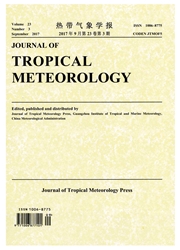

 中文摘要:
中文摘要:
热带气旋是在更温暖的热带海洋发生并且在它的中心附近很快旋转并且同时沿着包围流动移动的一种强烈天气系统。大规模发行量在决定热带气旋的运动和驾驶流动的效果是在预报热带气旋运动和轨道的最高的优先级起一个主要作用,这通常被认出。这篇文章采用一个新方法导出驾驶流动并且选择一个典型转弯轨道盒子(台风丹,编码了 9914 ) 说明方法的有效性。一般途径是修改涡度, geostropical 涡度和分叉,分别地,在非分叉的流函数, geoptential 和速度潜力调查变化并且计算修改速度域决定驾驶流动。不同于在象风地或 geopoential 高度的加权的一般水准那样的常规使用的另外的方法,这个方法在环境地上有最不不利的效果并且能导出与暴风雨运动适合很好的合适的驾驶流动。与另外的内部、外部的 forcings 结合了,这个方法能在热带气旋轨道的预言有宽申请。
 英文摘要:
英文摘要:
A tropical cyclone is a kind of violent weather system that takes place in warmer tropical oceans and spins rapidly around its center and at the same time moves along surrounding flows. It is generally recognized that the large-scale circulation plays a major role in determining the movement of tropical cyclones and the effects of steering flows are the highest priority in the forecasting of tropical cyclone motion and track. This article adopts a new method to derive the steering flow and select a typical swerving track case (typhoon Dan, coded 9914) to illustrate the validity of the method. The general approach is to modify the vorticity, geostropical vorticity and divergence, investigate the change in the non-divergent stream function, geoptential and velocity potential, respectively, and compute a modified velocity field to determine the steering flow. Unlike other methods in regular use such as weighted average of wind fields or geopoential height, this method has the least adverse effects on the environmental field and could derive a proper steering flow which fits well with storm motion. Combined with other internal and external forcings, this method could have wide application in the prediction of tropical cyclone track.
 同期刊论文项目
同期刊论文项目
 同项目期刊论文
同项目期刊论文
 Gao Shouting, Yushu Zhou.Xiaofan Li. 2007: Effects of Diurnal Variations on Tropical Equilibrium Sta
Gao Shouting, Yushu Zhou.Xiaofan Li. 2007: Effects of Diurnal Variations on Tropical Equilibrium Sta Guo Deng, Dalin Zhang, Tong Zhu, Angsheng Wang.2009: Use of the advanced microwave sounding unit dat
Guo Deng, Dalin Zhang, Tong Zhu, Angsheng Wang.2009: Use of the advanced microwave sounding unit dat Zhou yushu, Cui Xiaopeng, Li Xiaofan. 2006:Contribution of cloud condensate to surface rainfall proc
Zhou yushu, Cui Xiaopeng, Li Xiaofan. 2006:Contribution of cloud condensate to surface rainfall proc 期刊信息
期刊信息
